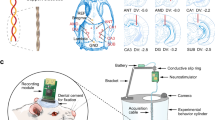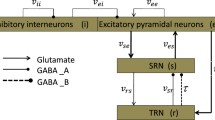Abstract
Amygdala kindling is a common temporal lobe-like seizure model. In the present study, temporal and spectral analyses of the ictal period were investigated throughout amygdala kindling in response to different behavioral seizures. Right-side amygdala was kindled to induce epileptiform afterdischarges (ADs). ADs of both the frontal cortex and amygdala were analyzed. Powers of the low (0–9 Hz)- and high (12–30 Hz)-frequency bands in response to different behavioral seizures were calculated. Densities of upward and downward peaks of spikes, which reflected information of spike count and spike pattern, throughout kindle-induced ADs were calculated. Progression was seen in the temporal and spectral characteristics of amygdala-kindled ADs in response to behaviors. Numbers of significant differences of all 1-s AD segments between two Racine’s seizure stages were significantly higher in upward and downward indexes of the temporal spike than those using the spectral method in both the amygdala and neocortex. Ability for distinguishing seizure stages was significantly higher in temporal spike density of amygdala ADs compared to those of frontal ADs. Our results showed that amygdala kindling caused spectrotemporal changes of activities in the amygdala and frontal cortex. The density of spike-related peaks had better distinguishability in response to behavioral seizures, particularly in a seizure zone of amygdala. The present study provides a new temporal index of spike’s peak density to understand progression of motor seizures in the kindling process.








Similar content being viewed by others
References
Akman O, Karson A, Aker RG, Ates N, Onat FY (2008) Hippocampal kindling in rats with absence epilepsy resembles amygdaloid kindling. Epilepsy Res 81:211–219
Blumenfeld H, Rivera M, Vasquez JG, Shah A, Ismail D et al (2007) Neocortical and thalamic spread of amygdala kindled seizures. Epilepsia 48:254–262
Blumenfeld H, Lampert A, Klein JP, Mission J, Chen MC et al (2009) Role of hippocampal sodium channel Nav1.6 in kindling epileptogenesis. Epilepsia 50:44–55
Boon P, Vonck K, De Herdt V, Van Dycke A, Goethals M et al (2007) Deep brain stimulation in patients with refractory temporal lobe epilepsy. Epilepsia 48:1551–1560
Bragin A, Engel J Jr, Wilson CL, Vizentin E, Mathern GW (1999) Electrophysiologic analysis of a chronic seizure model after unilateral hippocampal KA injection. Epilepsia 40:1210–1221
Brodbeck V, Thut G, Spinelli L, Romei V, Tyrand R et al (2010) Effects of repetitive transcranial magnetic stimulation on spike pattern and topography in patients with focal epilepsy. Brain Topogr 22:267–280
Chassagnon S, de Vasconcelos AP, Ferrandon A, Koning E, Marescaux C et al (2005) Time course and mapping of cerebral perfusion during amygdala secondarily generalized seizures. Epilepsia 46:1178–1187
Chen X, Sure U, Haag A, Knake S, Fritsch B et al (2006) Predictive value of electrocorticography in epilepsy patients with unilateral hippocampal sclerosis undergoing selective amygdalohippocampectomy. Neurosurg Rev 29:108–113
Chen SD, Wang YL, Liang SF, Shaw FZ (2016) Rapid amygdala kindling causes motor seizure and comorbidity of anxiety- and depression-like behaviors in rats. Front Behav Neurosci 10:129
Collins RC, Carnes KM, Price JL (1988) Prefrontal-limbic epilepsy: experimental functional anatomy. J Clin Neurophysiol 5:105–117
Davey BL, Fright WR, Carroll GJ, Jones RD (1989) Expert system approach to detection of epileptiform activity in the EEG. Med Biol Eng Comput 27:365–370
de Curtis M, Avanzini G (2001) Interictal spikes in focal epileptogenesis. Prog Neurobiol 63:541–567
Faure C (1985) Attributed strings for recognition of epileptic transients in EEG. Int J Biomed Comput 16:217–229
Ferrillo F, Beelke M, Nobili L (2000) Sleep EEG synchronization mechanisms and activation of interictal epileptic spikes. Clin Neurophysiol 111(Suppl 2):S65–S73
Goddard GV (1983) The kindling model of epilepsy. Trends Neurosci 6:275–279
Graebenitz S, Kedo O, Speckmann EJ, Gorji A, Panneck H et al (2011) Interictal-like network activity and receptor expression in the epileptic human lateral amygdala. Brain 134:2929–2947
Jalilifar M, Yadollahpour A, Moazedi AA, Ghotbeddin Z (2016) Classifying amygdala kindling stages using quantitative assessments of extracellular recording of EEG in rats. Brain Res Bull 127:148–155
Javidan M (2012) Electroencephalography in mesial temporal lobe epilepsy: a review. Epilepsy Res Treat 2012:637430
Kaplan PW, Schlattman DK (2012) Comparison of triphasic waves and epileptic discharges in one patient with genetic epilepsy. J Clin Neurophysiol 29:458–461
King DW, Smith JR (1996) Supplementary sensorimotor area epilepsy in adults. Adv Neurol 70:285–291
Liang SF, Liao YC, Shaw FZ, Chang DW, Young CP et al (2011) Closed-loop seizure control on epileptic rat models. J Neural Eng 8:045001
Liang SF, Chen YC, Wang YL, Chen PT, Yang CH et al (2013) A hierarchical approach for online temporal lobe seizure detection in long-term intracranial EEG recordings. J Neural Eng 10:045004
Martinerie J, Adam C, Le Van Quyen M, Baulac M, Clemenceau S et al (1998) Epileptic seizures can be anticipated by non-linear analysis. Nat Med 4:1173–1176
Milligan N, Oxley J, Richens A (1983) Acute effects of intravenous phenytoin on the frequency of inter-ictal spikes in man. Br J Clin Pharmacol 16:285–289
Morimoto K, Fahnestock M, Racine RJ (2004) Kindling and status epilepticus models of epilepsy: rewiring the brain. Prog Neurobiol 73:1–60
Musto AE, Samii MS, Hayes JF (2009) Different phases of afterdischarge during rapid kindling procedure in mice. Epilepsy Res 85:199–205
Neugebauer V, Keele NB, Shinnick-Gallagher P (1997) Epileptogenesis in vivo enhances the sensitivity of inhibitory presynaptic metabotropic glutamate receptors in basolateral amygdala neurons in vitro. J Neurosci 17:983–995
Nita DA, Cisse Y, Timofeev I, Steriade M (2007) Waking-sleep modulation of paroxysmal activities induced by partial cortical deafferentation. Cereb Cortex 17:272–283
Panayiotopoulos CP, Michael M, Sanders S, Valeta T, Koutroumanidis M (2008) Benign childhood focal epilepsies: assessment of established and newly recognized syndromes. Brain 131:2264–2286
Pitkanen A, Tuunanen J, Kalviainen R, Partanen K, Salmenpera T (1998) Amygdala damage in experimental and human temporal lobe epilepsy. Epilepsy Res 32:233–253
Racine RJ (1972) Modification of seizure activity by electrical stimulation. II. Motor seizure. Electroencephalogr Clin Neurophysiol 32:281–294
Racine RJ (1975) Modification of seizure activity by electrical stimulation: cortical areas. Electroencephalogr Clin Neurophysiol 38:1–12
Shaw FZ, Lai CJ, Chiu TH (2002) A low-noise flexible integrated system for recording and analysis of multiple electrical signals during sleep-wake states in rats. J Neurosci Methods 118:77–87
Shaw FZ, Liao YF, Chen RF, Huang YH, Lin RC (2013) The zona incerta modulates spontaneous spike-wave discharges in the rat. J Neurophysiol 109:2505–2516
Srinivasan V, Eswaran C, Sriraam N (2007) Approximate entropy-based epileptic EEG detection using artificial neural networks. IEEE Trans Inform Tech Biomed 11:288–295
Tsuchiya K, Kogure S (2011) Fast Fourier transformation analysis of kindling-induced afterdischarge in the rabbit hippocampus. Epilepsy Res 95:144–151
Tsuchiya K, Kogure S (2012) Spectral analysis of bilateral or alternate-site kindling-induced afterdischarges in the rabbit hippocampi. Epilepsy Res 101:228–236
Van Paesschen W, Connelly A, Johnson CL, Duncan JS (1996) The amygdala and intractable temporal lobe epilepsy: a quantitative magnetic resonance imaging study. Neurology 47:1021–1031
Vonck K, Boon P, Achten E, De Reuck J, Caemaert J (2002) Long-term amygdalohippocampal stimulation for refractory temporal lobe epilepsy. Ann Neurol 52:556–565
Wang YL, Chen YL, Su AW, Shaw FZ, Liang SF (2016) Epileptic pattern recognition and discovery of the local field potential in amygdala kindling process. IEEE Trans Neural Syst Rehabil Eng 24:374–385
White A, Williams PA, Hellier JL, Clark S, Dudek FE et al (2010) EEG spike activity precedes epilepsy after kainate-induced status epilepticus. Epilepsia 51:371–383
Wilkus RJ, Dodrill CB (1976) Neuropsychological correlates of the electroencephalogram in epileptics: I. Topographic distribution and average rate of epileptiform activity. Epilepsia 17:89–100
Zandi AS, Javidan M, Dumont GA, Tafreshi R (2010) Automated real-time epileptic seizure detection in scalp EEG recordings using an algorithm based on wavelet packet transform. IEEE Trans Biomed Eng 57:1639–1651
Zhang Y, Xu G, Wang J, Liang L (2010) An automatic patient-specific seizure onset detection method in intracranial EEG based on incremental nonlinear dimensionality reduction. Comput Biol Med 40:889–899
Acknowledgements
The authors thank Ms. Yu-Hsing Huang and Yin-Lin Chen for their technical supports and animal preparation. We appreciate official support from the University of South Australia. This work was supported by the Ministry of Science and Technology (MOST103-2314-B-006-021-MY2 and MOST106-2420-H-006-003), Taiwan. This study is also supported by “Aim for the Top University Plan” of the National Chiao Tung University and Ministry of Education, Taiwan.
Author information
Authors and Affiliations
Corresponding author
Rights and permissions
About this article
Cite this article
Wang, YL., Liang, SF., Su, A.W.Y. et al. Spike densities of the amygdala and neocortex reflect progression of kindled motor seizures. Med Biol Eng Comput 56, 99–112 (2018). https://doi.org/10.1007/s11517-017-1672-4
Received:
Accepted:
Published:
Issue Date:
DOI: https://doi.org/10.1007/s11517-017-1672-4




